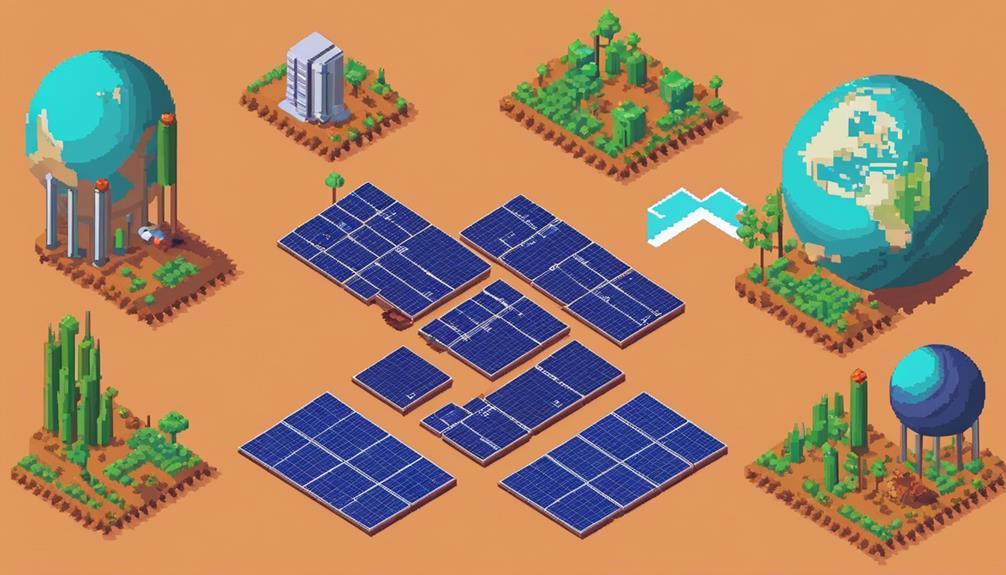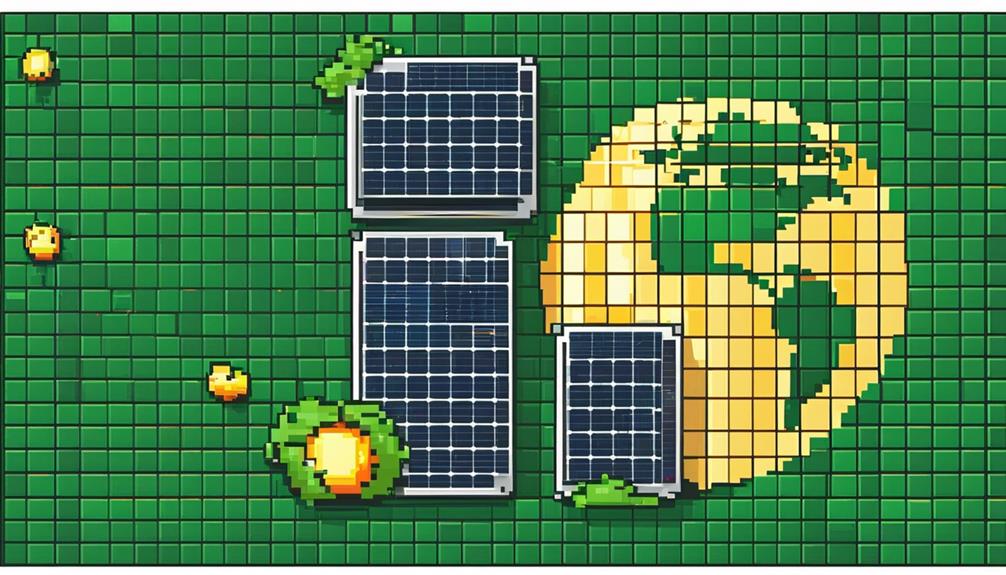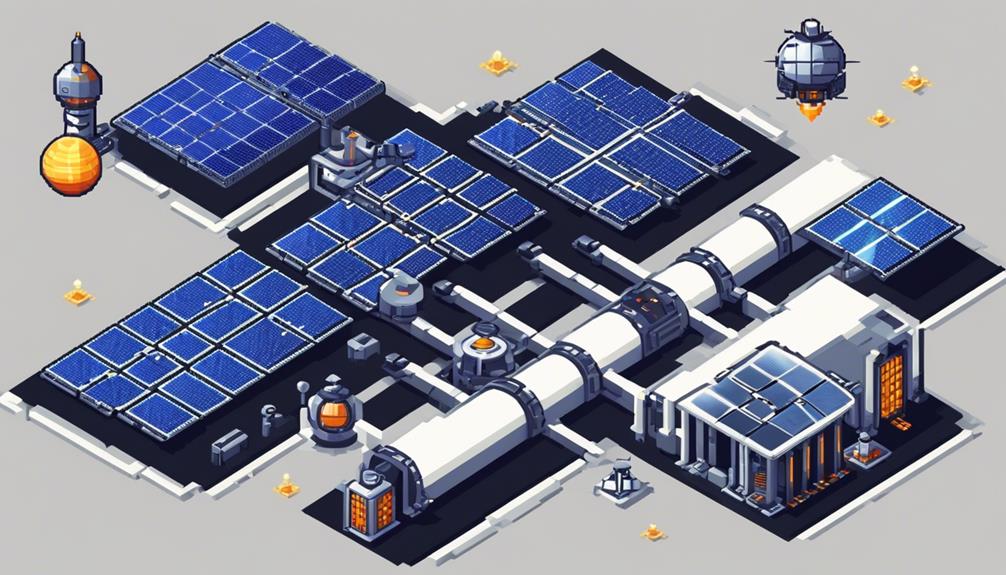Space Solar Power, with its promise of clean, continuous energy, presents a compelling case for environmental sustainability. While the benefits are clear in terms of reduced emissions and land usage, the challenges ahead are intricate. From the intricacies of power transmission in space to the economic viability of large-scale implementation, a nuanced understanding of the environmental implications is crucial. Considerations such as space debris mitigation and regulatory frameworks will play pivotal roles in shaping the future landscape of Space Solar Power.
Key Takeaways
- Space Solar Power reduces greenhouse gas emissions and minimizes environmental harm.
- It enhances sustainability by utilizing clean and renewable energy sources.
- Space Solar Power contributes to a more sustainable energy future.
- It minimizes air and water pollution, offering a cleaner energy alternative.
Overview of Space Solar Power

In the realm of sustainable energy solutions, Space Solar Power emerges as a revolutionary concept aimed at harnessing solar energy in space and transmitting it wirelessly to Earth. This innovative technology involves the collection of solar energy in space using solar panels equipped with reflectors or inflatable mirrors. Once captured, the energy is beamed down to Earth through the use of microwaves or lasers. The receiving stations on Earth consist of microwave antennas known as rectennas, which convert the transmitted energy back into electricity for distribution.
One of the most compelling aspects of Space Solar Power is its potential to provide significantly more energy than the world currently consumes. This abundance of clean energy has the capacity to address global energy demands while minimizing the environmental impact associated with traditional energy sources. Unlike fossil fuels, solar power does not produce greenhouse gas emissions or other pollutants that contribute to climate change and air pollution. Additionally, the space-based nature of this technology helps to avoid land use issues and environmental disruption commonly associated with terrestrial solar installations. Overall, Space Solar Power represents a promising avenue for meeting energy needs sustainably and with reduced environmental consequences.
Benefits of Space Solar Power
Space solar power presents significant benefits such as increased energy efficiency, reduced environmental impacts, and cost-effectiveness in implementation. These advantages stem from its ability to provide continuous energy availability without greenhouse gas emissions, avoiding competition for vital resources like water and land. Additionally, the technology's potential to bolster energy independence and create job opportunities in the aerospace sector further underscores its appeal.
Energy Efficiency Advantages
Harnessing solar energy in the abundant and uninterrupted space environment offers significant energy efficiency advantages for space solar power systems. Space solar power systems benefit from the following advantages:
- Elimination of atmospheric interference enhances efficiency.
- Maximization of sunlight exposure boosts energy generation.
- Wireless power transmission reduces energy losses during transportation.
- Continuous energy generation ensures reliability and efficiency.
- Minimal environmental impact promotes sustainability and efficiency.
These factors contribute to the overall energy efficiency of space solar power systems, making them a promising solution for sustainable and reliable electricity generation. By leveraging the unique conditions of space, such systems can provide clean energy with high efficiency and minimal impact on the environment.
Environmental Impact Reduction
Efficiency enhancements and environmental benefits converge in the realm of Space Solar Power, showcasing a sustainable solution with profound impact reduction potential. Space Solar Power (SBSP) holds the promise of reducing greenhouse gas emissions and eliminating hazardous waste production entirely. By harnessing solar power from space, this technology significantly minimizes air and water pollution in comparison to conventional fossil fuel energy generation methods. The utilization of solar panels in space provides a clean and renewable energy source that leaves minimal environmental footprint. SBSP technology plays a crucial role in lessening the ecological impact of energy production, paving the way for a more sustainable and environmentally friendly energy future. The implementation of Space Solar Power underscores its potential to contribute positively to reducing environmental harm while providing clean power sustainably.
Cost-Effectiveness of Implementation
With the potential for substantial long-term cost savings and reduced reliance on expensive fossil fuels, the implementation of space solar power presents an economically advantageous solution for sustainable energy generation. Space solar power offers a cost-effective solution by utilizing abundant solar energy in space. It provides a long-term benefit with minimal operational costs once the system is established. The continuous energy generation from space solar power can outweigh the initial investment over time. Space solar power reduces reliance on expensive fossil fuels, leading to potential cost savings. With technological advancements, the cost-effectiveness of space solar power implementation is improving rapidly.
Challenges of Space Solar Power
The challenges of Space Solar Power encompass complex technical issues such as ensuring high transmission efficiency over vast distances. Moreover, the risks associated with orbital debris necessitate meticulous planning to safeguard satellite operations. Additionally, the intricate logistics of maintaining space-based solar power systems present a multifaceted challenge that demands innovative solutions.
Transmission Efficiency Challenges
Addressing the challenges of transmission efficiency in Space Solar Power systems is crucial for optimizing energy delivery and ensuring the economic viability and widespread adoption of this technology. Efficient transmission of power from satellites to Earth is essential for the success of Space Solar Power. Factors like atmospheric interference and weather conditions can affect the effectiveness of energy transfer over long distances. Ongoing research focuses on enhancing the efficiency of wireless power transmission to maximize energy delivery. Overcoming these transmission efficiency challenges is vital for the advancement of Space Solar Power technology and its integration into our energy infrastructure.
- Losses during wireless energy transmission from satellites to Earth
- Maintaining high efficiency over long distances
- Impact of atmospheric interference and weather conditions
- Research to improve wireless power transmission efficiency
- Essential for economic viability and widespread adoption
Orbital Debris Risks
Efficient transmission of power from satellites to Earth in Space Solar Power systems is essential, but the challenge of orbital debris risks presents significant threats to the safe operation and longevity of this technology. Space Solar Power systems are vulnerable to damage from orbital debris, endangering satellites and solar panels. Even small debris particles can cause substantial harm to the delicate components of these systems, impacting their functionality. To safeguard Space Solar Power infrastructure, mitigation strategies like debris tracking and satellite maneuvering to avoid collisions are imperative. The risks associated with orbital debris underscore the critical need for space sustainability and responsible practices in the advancement of Space Solar Power technology, emphasizing the importance of proactive measures to ensure the safety and effectiveness of these systems.
Maintenance Logistics Complexity
Navigating the intricacies of maintenance logistics for space-based solar power systems entails orchestrating a symphony of operations in the challenging expanse of space. The complexities involved in managing maintenance missions for space-based solar power systems include:
- Scheduling maintenance missions efficiently.
- Coordinating with ground control for seamless operations.
- Ensuring the safety of maintenance crews in the harsh space environment.
- Utilizing specialized equipment and trained personnel for repairs or replacements.
- Addressing time-sensitive tasks to maintain continuous energy generation while considering extreme temperatures and other environmental factors.
These challenges highlight the demanding nature of maintaining space-based solar power systems and the critical role logistics play in their functionality and longevity.
Environmental Impact on Earth
Space-based solar power offers a promising solution to mitigate environmental impact on Earth through its zero greenhouse gas emissions and minimal land use requirements. Solar energy beamed from space to Earth presents a cleaner alternative to traditional fossil fuel energy generation, significantly reducing air pollution and combating climate change. The efficient wireless power transmission technology ensures minimal energy losses during distribution, enhancing the sustainability of the energy supply. By eliminating the need for extensive ground installations, space solar power helps in preserving natural habitats and ecosystems on Earth.
| Benefits of Space Solar Power on Earth |
|---|
| Zero greenhouse gas emissions |
| Minimal land use impact |
| Reduced air pollution |
Implementing space solar power systems can play a crucial role in addressing environmental concerns while meeting the growing energy demands sustainably. This innovative approach not only reduces the carbon footprint but also contributes to the conservation of Earth's ecosystems. By harnessing the power of solar energy from space, we can pave the way for a cleaner and greener energy future, ensuring a more environmentally friendly approach to meeting our energy needs.
Mitigation of Space Debris

Space solar power systems face a significant challenge in the form of space debris, which poses a threat to their operational integrity and longevity through potential satellite and solar panel damage. Mitigation strategies are crucial to ensuring the effectiveness and safety of these systems in orbit. Here are some key strategies being employed:
- Designing Satellites with Deorbiting Capabilities: Satellites are being designed with systems that allow them to safely deorbit at the end of their operational life, reducing the amount of debris left in orbit.
- Development of Active Debris Removal Technologies: Technologies are being developed to actively remove space debris from orbit, reducing the risk of collisions and damage to satellites and solar panels.
- Establishment of International Guidelines and Standards: International cooperation is essential in setting guidelines and standards to minimize the creation of new space debris and regulate activities in space.
- Collaborative Efforts Between Space Agencies: Space agencies and organizations are working together to address the growing concern of space debris and its impact on space-based technologies like solar power systems.
- Research and Innovation: Continued research and innovation are vital in developing new technologies and strategies to mitigate the risks posed by space debris to space solar power systems.
Energy Transmission Efficiency
Efficiency in energy transmission plays a critical role in optimizing the performance and sustainability of solar power systems in space. Space-based solar power systems have demonstrated the potential to achieve energy transmission efficiencies of around 80% or higher. This high efficiency is essential for maximizing the amount of solar energy captured in space and transmitting it to Earth with minimal losses. Wireless power transmission technologies, such as microwave beams or lasers, are commonly employed to transmit energy from satellites to Earth, enabling the harnessing of solar power in space for terrestrial use.
To highlight the importance of energy transmission efficiency in space solar power systems, the table below summarizes key points related to this aspect:
| Aspect | Details |
|---|---|
| Efficiency | Space solar power systems can achieve efficiencies of 80% or higher. |
| Energy Transmission | Wireless technologies like microwaves and lasers are utilized for transmitting energy from space to Earth. |
| Sustainability | Higher transmission efficiencies contribute to the overall sustainability of space-based solar power. |
| Ongoing Research | Research efforts focus on enhancing the efficiency of wireless power transmission systems for space solar power applications. |
Efforts to enhance the efficiency of wireless power transmission systems are crucial for improving the overall effectiveness and sustainability of space solar power initiatives. By minimizing energy losses during long-distance transmission, these advancements can further propel the adoption of space-based solar power as a viable and environmentally friendly energy source.
Space Solar Power Vs. Fossil Fuels

In the comparison between space solar power and fossil fuels, the environmental impact of each energy source starkly contrasts in terms of greenhouse gas emissions and ecosystem preservation. Space solar power produces 0% greenhouse gas emissions, making it a clean and sustainable energy source. On the other hand, fossil fuels are major contributors to global warming due to the release of greenhouse gases during combustion. Here are some key points differentiating the environmental impact of space solar power and fossil fuels:
- Greenhouse Gas Emissions: Space solar power produces no greenhouse gas emissions, while fossil fuels release significant amounts of greenhouse gases like carbon dioxide, contributing to climate change.
- Ecosystem Preservation: Space solar power has minimal impact on ecosystems, unlike fossil fuels that require extensive mining and drilling operations, leading to habitat destruction and environmental pollution.
- Sustainable Energy: Space solar power is a sustainable energy source that can help reduce environmental degradation and combat climate change, unlike the extraction and burning of finite fossil fuel resources.
- Environmental Impact: Fossil fuel combustion releases harmful pollutants into the air and water, negatively affecting human health and the environment. In contrast, space solar power is clean and non-polluting.
- Transition Potential: Transitioning from fossil fuels to space solar power can significantly reduce environmental harm and promote a greener, more sustainable future.
Space Solar Power Vs. Land Use
Space solar power systems offer a distinct advantage over ground-based installations in terms of land efficiency. By utilizing space for solar power generation, the need for vast land areas is significantly reduced. This approach minimizes competition with land used for agriculture or urban development, resulting in reduced environmental impact and land degradation.
Land Efficiency Comparison
Utilizing land resources efficiently is a critical consideration when comparing solar power generation methods between ground-based and space-based systems. Space solar power proves to be significantly more land-efficient than ground-based solar power due to its unique ability to collect solar energy in space. Here are some key points to consider:
- Ground-based solar panels require 3.5 to 10 acres per megawatt, while space-based systems use minimal land area for satellite deployment.
- Space-based solar power systems in geostationary orbit benefit from continuous exposure to sunlight, maximizing energy collection efficiency without extensive land requirements.
- By utilizing space for solar energy collection, space solar power minimizes land degradation and habitat loss associated with large-scale ground-based solar facilities.
- Space solar power offers a more sustainable and environmentally friendly approach to solar energy generation by reducing land use impacts.
Environmental Impact Assessment
Comparing the environmental impact assessment of space solar power to traditional land-based solar installations reveals significant advantages in minimizing land use and habitat disruption. Space-based solar power systems exhibit a clear edge in environmental sustainability by avoiding the extensive land requirements that ground-based solar projects demand. The table below underscores the key differences in land use impact between these two approaches:
| Aspect | Space Solar Power | Land-based Solar Installations |
|---|---|---|
| Land Use | Minimal | Extensive |
| Habitat Disruption | Reduced | Potential for disruption |
| Environmental Footprint | Small | Significant |
Space solar power emerges as a more environmentally friendly option, offering sustainable energy generation with minimal land use impact and habitat disturbance.
Space Solar Power and Water Resources

Considering the water-efficient nature of space solar power systems, their operational processes stand out for their minimal water requirements compared to terrestrial solar power technologies. Space solar power systems do not rely on water for electricity generation, distinguishing them as a sustainable and environmentally friendly energy source. While the manufacturing of solar PV components may involve water usage, the operation phase of space-based solar power systems remains water-free. In cases where concentrated solar power (CSP) plants are utilized in space, water may be required for cooling purposes; however, advancements in dry-cooling technology have the potential to significantly reduce water consumption in these systems. Wet-recirculating CSP plants in space can consume between 600-650 gallons of water per megawatt-hour, underscoring the importance of efficient water management practices in space-based solar power technologies. Minimizing water usage in these systems is paramount for ensuring their sustainability and reducing their environmental impact.
- Space solar power systems do not require water for electricity generation.
- Manufacturing solar PV components may involve water usage, but operation is water-free.
- Advancements in dry-cooling technology can reduce water consumption in CSP plants.
- Wet-recirculating CSP plants in space can use 600-650 gallons of water per megawatt-hour.
- Efficient water management is essential for sustainable space-based solar power generation.
Space Solar Power and Wildlife
Space solar power systems pose potential challenges to wildlife due to the transmission of energy beams and electromagnetic fields, necessitating thorough study and implementation of mitigation measures to safeguard biodiversity. The wireless transmission of energy from space can disrupt wildlife habitats and behavior, impacting various species, particularly birds and flying animals that may be at risk of collision with the beams or structures of these systems. Additionally, the electromagnetic fields generated during the energy transmission process can further affect wildlife, requiring careful assessment.
To address these concerns, comprehensive studies on the impact of space-based solar power on wildlife behavior and migration patterns are essential. Mitigation measures must be developed and implemented to minimize adverse effects on wildlife populations. These measures could include modifying the design of energy transmission systems to reduce risks to wildlife, implementing warning signals to deter animals from approaching hazardous areas, and conducting ongoing monitoring to assess the effectiveness of mitigation strategies.
| Challenges for Wildlife Due to Space Solar Power | Mitigation Measures |
|---|---|
| Disruption of habitats and behavior | Modify system design |
| Risk of collision for birds and flying species | Implement warning signals |
| Effects of electromagnetic fields on wildlife | Conduct ongoing monitoring |
| Impact on migration patterns | Assess mitigation effectiveness |
Space Solar Power and Climate Change

The impact of space solar power on climate change is significant due to its ability to provide a clean energy source that mitigates greenhouse gas emissions. By reducing dependence on fossil fuels, space solar power contributes to combating climate change by offering a sustainable alternative energy solution. Implementing this technology can lead to a substantial decrease in air and water pollution, thereby aiding in the global effort towards a greener future.
Solar Impact on Climate
Harnessing solar energy from space for power generation presents a promising strategy in reducing greenhouse gas emissions and addressing the challenges of climate change. This innovative approach can significantly impact the climate by decreasing reliance on traditional fossil fuels and promoting renewable energy sources. Key points to consider include:
- Space solar power can help combat climate change by reducing greenhouse gas emissions from traditional fossil fuel sources.
- Implementing space solar power can reduce the reliance on fossil fuels, which are major contributors to climate change.
- Space solar power systems offer a sustainable solution to address climate change by providing clean and renewable energy.
- The adoption of space solar power technology can play a significant role in transitioning to a low-carbon economy and combating climate change.
- Harnessing solar energy in space for power generation can contribute to mitigating the impact of global warming.
Mitigating Greenhouse Gas
To address the challenges of climate change and reduce greenhouse gas emissions, the utilization of space-based solar power technology presents a viable solution. Space-based solar power does not emit greenhouse gases during energy generation, offering a clean and sustainable energy source. By reducing our reliance on fossil fuels through space solar power, we can contribute significantly to mitigating climate change. Implementing space solar power technologies can play a crucial role in transitioning to a low-carbon economy and reducing global greenhouse gas emissions. This renewable energy source provides continuous energy production with minimal environmental impact, making it an attractive option for combating climate change.
| Benefits of Space Solar Power | |
|---|---|
| Clean Energy | Minimal Environmental Impact |
| Reduced Greenhouse Gas Emissions | Contribution to Mitigating Climate Change |
Space Solar Power and Greenhouse Gas Emissions
Space solar power technology presents a promising solution for mitigating greenhouse gas emissions in the energy sector. By utilizing solar power harvested in space, this innovative approach offers significant benefits in the fight against climate change and reducing greenhouse gas emissions. Some key points to consider include:
- Space solar power does not emit greenhouse gases during energy generation.
- The use of space solar power contributes to reducing overall greenhouse gas emissions.
- Harnessing solar energy in space can help mitigate the impact of climate change caused by traditional power generation methods.
- Space solar power technology aligns with global efforts to combat climate change and reduce greenhouse gas emissions.
- Transitioning to space solar power can play a crucial role in achieving a more sustainable and environmentally friendly energy infrastructure.
With these advantages, space solar power emerges as a viable and environmentally sound alternative to traditional energy sources. By embracing this technology, we can make significant strides towards a greener future while addressing the pressing issues of greenhouse gas emissions and climate change.
Regulatory Considerations for Space Solar Power

Considering the regulatory landscape for space solar power, adherence to international agreements and wireless power transmission protocols is imperative to ensure the safe and sustainable deployment of solar power systems in space. International agreements play a significant role in governing space activities related to space-based solar power (SBSP). The United Nations Outer Space Treaty and the International Telecommunication Union (ITU) Radio Regulations are key frameworks that regulate space activities and frequency allocations for SBSP, ensuring responsible conduct and coordination among nations. These agreements help in preventing conflicts, ensuring spectrum coordination, and fostering cooperation for the peaceful use of outer space.
In addition to international agreements, wireless power transmission protocols are essential for the effective operation of SBSP systems. These protocols govern the transmission of power from space-based platforms to receiving stations on Earth, ensuring efficiency and safety in power transfer processes. Moreover, licensing and authorization processes are crucial aspects of regulatory considerations for SBSP. Obtaining the necessary licenses and approvals from relevant authorities is essential for the establishment and operation of space-based solar power systems. Compliance with national and international space laws is fundamental to avoid legal issues, conflicts, and to promote the sustainable utilization of space resources for SBSP.
| Regulatory Considerations for Space Solar Power | ||
|---|---|---|
| International Agreements | Wireless Power Transmission | Licensing |
| Ensure responsible conduct in space activities | Govern power transmission protocols | Obtain necessary approvals for operation |
| Prevent conflicts and promote cooperation | Ensure efficiency and safety in power transfer | Ensure compliance with regulations |
| Facilitate spectrum coordination among nations | Prevent interference with other systems | Promote sustainable deployment practices |
Economic Implications of Space Solar Power
The economic viability of space solar power technology hinges on its potential to revolutionize energy generation and distribution systems. Space solar power can offer energy independence, reducing reliance on gas and other traditional fossil fuels. This shift not only has economic implications but also environmental benefits by decreasing greenhouse gas emissions and hazardous waste production associated with traditional energy sources.
Implementing space solar power technology can create new employment opportunities, particularly in the aerospace industry. The development, deployment, and maintenance of space-based solar power systems require a skilled workforce, leading to job growth in this sector. Furthermore, space solar power has the potential to enable energy export to any location on Earth. This opens up new economic opportunities for countries looking to diversify their energy sources and reduce costs associated with energy imports.
Moreover, space solar power can be harnessed for local needs such as desalination, providing clean energy solutions for communities. By utilizing this technology, regions can address energy demands sustainably while mitigating the environmental impact of traditional energy generation methods. Additionally, the advancement of space solar power technology can facilitate the development of low-cost space transportation systems, further enhancing economic prospects in the aerospace and related industries.
Public Perception of Space Solar Power

Given the economic and environmental implications of space solar power technology, understanding and managing public perception of SBSP is crucial for its successful adoption and integration into the energy landscape. Public perception of Space Solar Power (SBSP) is significantly influenced by concerns related to safety and potential risks associated with wireless power transmission. Individuals may harbor reservations about SBSP due to uncertainties surrounding the long-term effects of low-frequency electromagnetic radiation on both humans and the environment.
To ensure the widespread acceptance and adoption of SBSP technology, addressing challenges related to public perception is paramount. Educational campaigns that focus on transparent communication about the benefits and safety measures of SBSP can play a pivotal role in alleviating public concerns. By engaging in open dialogue and actively involving the public in discussions regarding SBSP, trust can be established, thereby facilitating acceptance and garnering support for this innovative energy solution.
It is imperative to emphasize the safety protocols and measures incorporated into SBSP technology to mitigate any perceived risks associated with wireless power transmission. Through proactive communication and dissemination of accurate information, misconceptions can be rectified, paving the way for a more informed and receptive public attitude towards the utilization of solar power from space.
Frequently Asked Questions
What Environmental Impacts Could Solar Power Have?
Solar power, despite its many environmental benefits, can still have some negative impacts. These include wildlife displacement due to habitat disruption, increased land use for solar installations, glare effect affecting nearby ecosystems, and the potential for heat island effect in concentrated solar areas. Implementing careful planning and monitoring measures can help mitigate these impacts and ensure that solar power remains a sustainable and environmentally friendly energy source.
What Are the Negatives of Space Based Solar Power?
Space-based solar power (SBSP) presents challenges such as increased space debris from satellite launches, potential radiation exposure during construction and maintenance, high launch costs due to required payloads and orbital maneuvers, and the ongoing need for orbital maintenance to ensure uninterrupted power transmission. Addressing these concerns through advanced technologies and rigorous safety protocols is essential for the successful implementation and sustainable operation of SBSP systems.
Why Not Put Solar Panels in Space?
Placing solar panels in space offers advantages like increased solar exposure and continuous operation. However, challenges such as space debris collisions, transmission losses in beaming power to Earth, high launch costs, and radiation exposure to equipment and personnel present obstacles to widespread implementation. Addressing these issues is crucial to maximize the potential benefits of space-based solar power while ensuring the safety and efficiency of the technology.
How Efficient Are Solar Panels in Space Compared to Earth?
Solar panels in space exhibit significantly higher efficiency compared to their Earth-based counterparts. The unobstructed exposure to solar radiation in space allows for more consistent energy generation. This increased space efficiency stems from uninterrupted sunlight, offering a vast improvement over Earth-based solar technology. As a result, space-based solar panels provide enhanced energy generation potential and environmental benefits due to their superior performance in harnessing solar energy.

